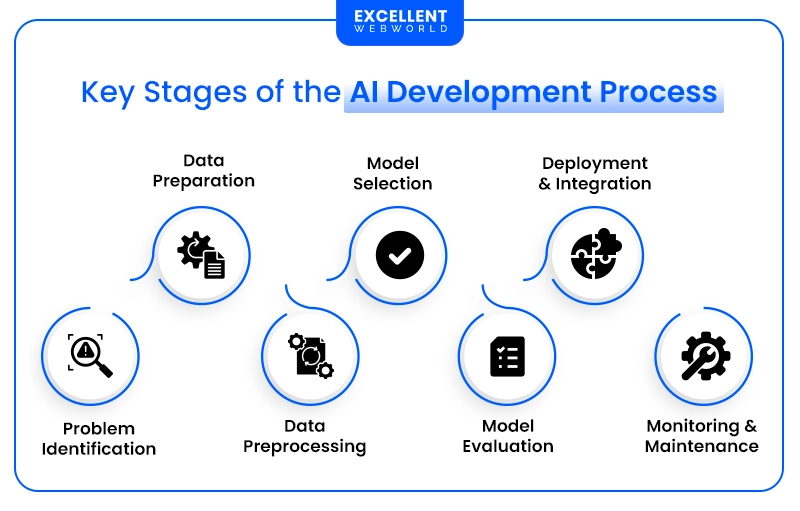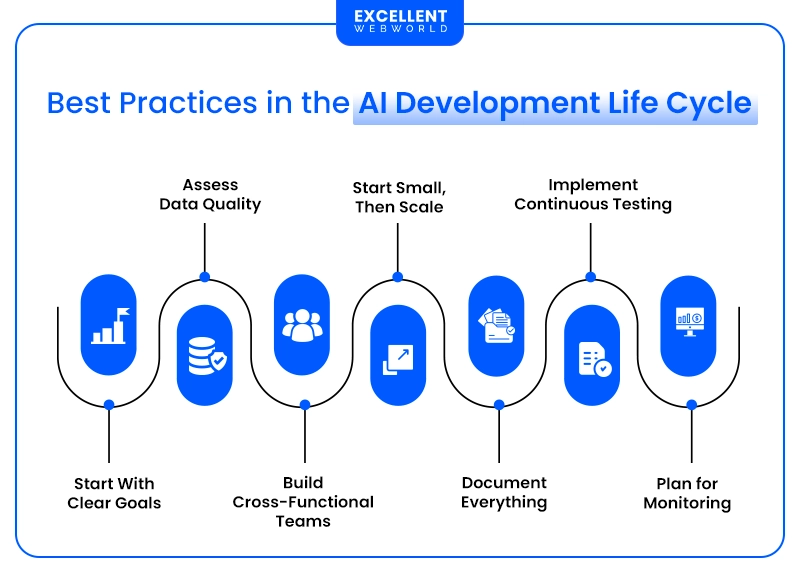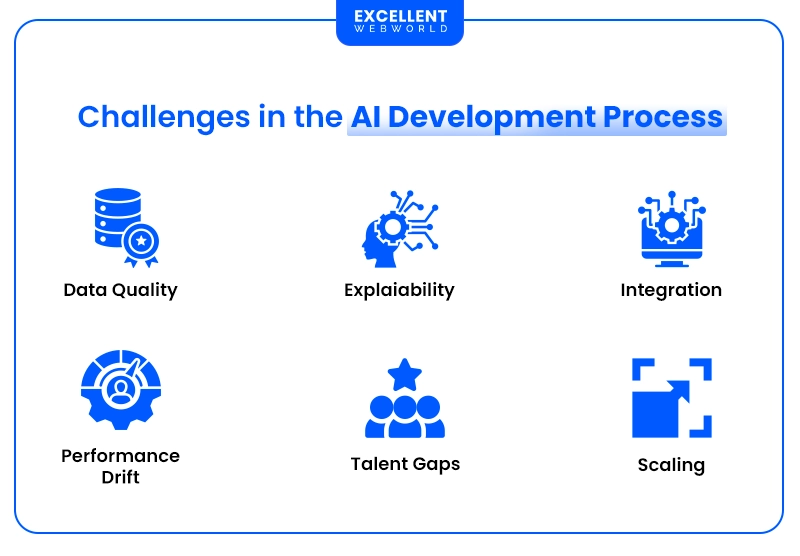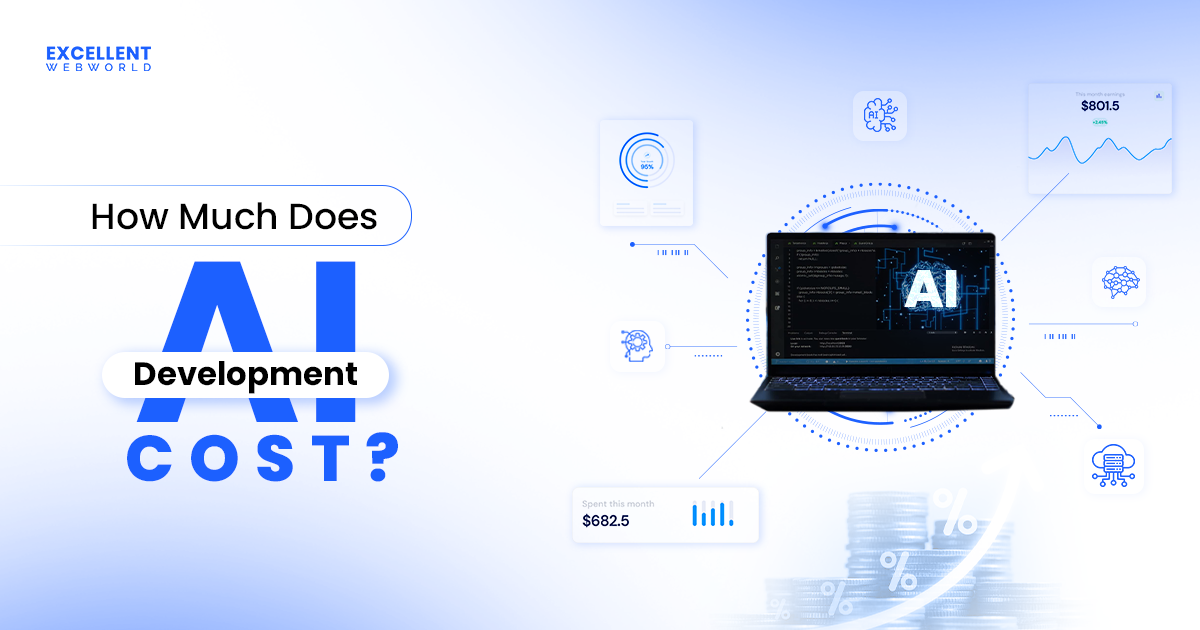Ever feel like you’re building your AI strategy on quicksand?
As a technology leader, you’ve likely wondered:
Think of the AI development life cycle as constructing a skyscraper rather than a simple house. Without the proper blueprint and foundation, even the most impressive structure will collapse, just like AI projects without appropriate governance and scalability considerations.
This guide breaks down all the steps within the AI development process, serving as your blueprint for success.
We’ll address the questions keeping you up at night: how to build repeatable procedures, control version float, and bridge expertise gaps inside your organization.
So, let’s get started!
What is the AI Development Life Cycle?
The artificial intelligence life cycle is a structured process for transforming AI concepts into working solutions. This data-driven approach involves several key phases from initial problem identification through final deployment and maintenance. Unlike traditional development, AI systems learn from data examples rather than following explicit programming instructions, requiring an iterative methodology.
This end-to-end AI development process typically includes:
Unlike traditional software development, the artificial intelligence project lifecycle is heavily data-driven and iterative. When AI models are developed, the system learns from examples rather than following explicit programming rules.
A successful AI software development process balances innovation with practical implementation, allowing you to build an AI app that delivers measurable value.
AI Development Life Cycle Use Case Example
Amazon’s product recommendation system is the best example of the AI life cycle:
This cycle guarantees that Amazon’s AI-driven recommendations will remain correct and valuable to users and the business.
Now that we know the AI development life cycle, let’s analyze its key stages to see how every step connects and contributes to building effective AI solutions.
Key Stages of the AI Development Process
AI development follows seven interconnected stages: defining problems and goals, collecting quality data, preprocessing and exploring datasets, selecting and training appropriate models, rigorous evaluation and validation, seamless deployment with system integration, and ongoing monitoring with maintenance. Success requires balancing technical excellence with practical business needs throughout this iterative journey.
Let’s break down the various AI development life cycle stages:
Step 1: Problem Identification & Goal Definition
Before jumping to code, you must recognize precisely what problem you’re solving. This is where your journey in developing AI software begins:
This stage is often rushed; however, taking time here prevents headaches later. As a technology leader, you must align technical possibilities with business objectives.
Step 2: Data Collection & Preparation
No data, no AI. The foundation of any AI system design is high-quality, relevant data:
Many AI projects stumble here because teams underestimate the complexity of data readiness. You’ll need to balance quick wins with building a sustainable data infrastructure.
Step 3: Data Exploration & Preprocessing
Raw data rarely works “as it is” when you build an AI model.
This critical phase includes:
Your teams might spend 60-80% of project time here, so plan accordingly. Investing in reusable data pipelines pays dividends across multiple projects.
Step 4: Model Selection & Training
Now comes the part most people think of when discussing creating any AI model:
This stage requires balancing technical elegance with practical needs. Sometimes, a simple model that works reliably is better than a complex one that’s hard to maintain.
Step 5: Model Evaluation & Validation
Before deployment, rigorous testing is essential in the phases of AI model development:
As a leader, you must define what “good enough” means for your specific use case, balancing perfect accuracy with time-to-market pressures.
Step 6: Deployment & Integration
A model sitting on a data scientist’s laptop creates no value. Getting it into production is where an AI development company would focus next:
This stage often reveals the gap between data science and engineering teams. Bridging this gap with MLOps practices helps ensure smooth deployments.
Step 7: Monitoring, Maintenance & Retraining
The AI lifecycle doesn’t end with deployment. Monitoring and maintaining AI systems is equally important for sustainable performance.
Every example of the successful AI life cycle includes:
This often-neglected phase determines whether your AI investment delivers sustained value or gradually degrades into irrelevance.
The AI development process isn’t strictly linear; you’ll often cycle back to earlier stages as you learn. Building a repeatable procedure that meets your business enterprise’s unique desires is your real challenge as a technical leader.
Now that we have covered the key stages of the AI development process, let’s study the tools & technologies that will help you during each stage.
Tools & Technologies for Each Stage of the AI Development Lifecycle
The proper tools could make your AI in app development smoother.
Here’s what you will need at every stage:
1. Problem Identification & Goal Definition
2. Data Collection & Preparation
3. Data Exploration & Preprocessing
4. Model Selection & Training
5. Model Evaluation & Validation
6. Deployment & Integration
7. Monitoring, Maintenance & Retraining
Choose tools that fit your team’s expertise and existing systems rather than the trendiest options.
Equipping each stage of the AI lifecycle with the right tools is crucial, but tools alone aren’t enough. These must be paired with proven best practices to drive real impact.
Best Practices in the AI Development Life Cycle
This section provides essential guidelines for navigating AI project challenges effectively. It covers foundational strategies for planning, team collaboration, implementation approaches, and sustainability practices that help development teams avoid common pitfalls, manage resources efficiently, and deliver successful AI solutions throughout the complex project lifecycle while ensuring long-term value.
1. Start With Clear Business Goals
Before diving into code, define what success looks like. Ask:
This clarity helps your AI development company focus on deliverables that matter to stakeholders.
2. Assess Data Quality Early
The foundation of any AI-driven software development is good data. Examine your data sources for:
Addressing these concerns during data preparation in AI development prevents major headaches later.
3. Build Cross-Functional Teamsy
AI projects need different skills working together. Include:
4. Start Small, Then Scale
Don’t try to solve everything at once. The most successful stages in building an AI solution begin with:
5. Document Everything
Keep detailed records of:
This documentation becomes invaluable during the AI model training and deployment process.
6. Implement Continuous Testing
Test throughout development, not just at the end.
Check for:
7. Plan for Ongoing Monitoring
Your work isn’t done after launch.
The final stage of AI integration in software development requires:
Following these AI development best practices helps you navigate the complex AI development landscape while delivering valuable, sustainable solutions.
Adopting best practices is essential, but the journey doesn’t come without obstacles. The following section will delve into the everyday challenges encountered during the AI development life cycle.
Challenges in the AI Development Process
AI development process presents distinct challenges beyond traditional software creation. Teams face critical issues, including poor data quality, unexplainable model decisions, difficult system integration, declining performance over time, skilled talent shortages, and scaling failures. These interconnected challenges require structured approaches and proactive planning to ensure successful AI implementation and long-term reliability.
Let’s explore these AI implementation challenges and how you can overcome them.
1. Data Quality Issues
Your AI models falter with messy data. Inconsistent, biased, or incomplete datasets lead to unreliable outputs that damage trust and adoption.
Pro Tip: Start with a data audit before any custom AI development challenges arise. Set up regular cleaning processes and validation steps.
2. Explainability Problems
When AI makes critical business decisions but can’t explain its reasoning, stakeholders hesitate to rely on results they can’t understand. This “black box” effect undermines trust and raises concerns about fairness, accountability, and regulatory compliance.
Pro Tip: Implement explainable AI techniques from day one of developing AI applications for businesses to maintain stakeholder confidence.
3. Integration Headaches
Legacy systems resist AI implementation. Your carefully developed models often clash with existing infrastructure, causing deployment delays and frustration.
Pro Tip: Map out all integration points early and create a phased approach to minimize disruptions.
4. Performance Drift
Models that performed well initially degrade over time as real-world conditions change, requiring constant attention to maintain accuracy.
Pro Tip: Robust AI model lifecycle management requires continuous monitoring and retraining schedules.
5. Talent Gaps
Finding professionals who understand complex AI technologies and your specific business context remains one of the most significant implementation barriers.
Pro Tip: Invest in upskilling your current team while partnering with specialists to hire AI developers for complex areas.
6. Scaling Challenges
Promising AI prototypes frequently collapse under production workloads, exposing flaws in architecture that weren’t visible during controlled testing.
Pro Tip: Address real-world AI development challenges by stress-testing your models with gradually increasing workloads before full deployment.
While these challenges seem daunting, they underscore the importance of a structured approach. Let’s decode the benefits of this approach in the upcoming section.
Benefits of Implementing a Robust AI Project Life Cycle
Following a strong AI project life cycle transforms how your team approaches AI development. This structured approach dramatically improves your chances of success while reducing costly risks and inefficiencies. Discover how the right methodology can turn your AI initiatives from uncertain experiments into predictable, value-driven business outcomes.
Here’s how it helps you:
Turning AI Knowledge Into Business Success
We’ve explored every step of building effective AI systems – from planning to deployment. Success in AI isn’t complicated: thoughtful planning, strong teamwork, quality data, and ongoing maintenance are your foundation.
As a technology leader, you have the roadmap to avoid costly mistakes and drive real business value with AI. Start small, learn continuously, and expand strategically.
However, implementing this roadmap is full of obstacles, and that’s where you will need an experienced and knowledgeable partner.
At Excellent Webworld, our AI consulting team has guided various businesses through every phase of AI development. We transform complex business problems into streamlined AI solutions that deliver measurable ROI.
So, why wait for anything to happen? Schedule a strategy session with our AI specialists and turn your vision into reality with tailor-made enterprise solutions.
FAQs Related To The AI Development Process:-
To develop software with AI, identify business needs, collect relevant data, select appropriate AI technologies, integrate with existing systems, and implement continuous improvement processes.
The AI project cycle ensures structured development, reduces risks, optimizes resource usage, and creates scalable solutions that align with business objectives.
AI development improves decision-making, automates repetitive tasks, unlocks insights from data, enhances customer experiences, and creates competitive advantages.
The four pillars are data preparation, model development, deployment & integration, and monitoring & maintenance.

Article By
Mayur Panchal is the CTO of Excellent Webworld. With his skills and expertise, He stays updated with industry trends and utilizes his technical expertise to address problems faced by entrepreneurs and startup owners.






